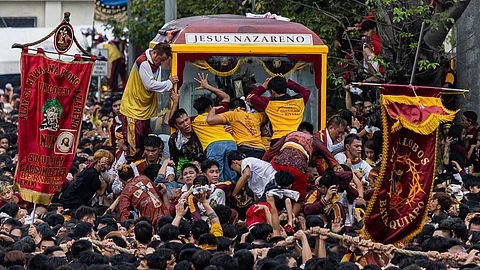
- NEWS
- the EDIT
- COMMENTARY
- BUSINESS
- LIFE
- SHOW
- ACTION
- GLOBAL GOALS
- SNAPS
- DYARYO TIRADA
- MORE

Hundreds of thousands of Catholic devotees converged in Manila on Thursday in an unparalleled display of faith and hope as they participated in the annual procession of the Black Nazarene.
The event, one of the largest religious gatherings in the predominantly Catholic Philippines, drew participants from across the country seeking miracles and blessings.
The procession began before dawn with an open-air Mass at Quirino Grandstand celebrated by Jose Cardinal Advincula.
During the Misa Mayor, the Cardinal emphasized the importance of hope and obedience in faith, equating the loss of hope to the loss of life.
“As long as we have hope, we’re living. We can’t live if we don’t have hope,” Advincula said. He reminded the faithful that true hope comes from Jesus Christ, urging them to follow His example of obedience.
“This year’s theme says God is more pleased with our obedience than offerings,” he said.
After the Mass, barefoot men and women clad in maroon shirts surged through the streets, straining to touch the carriage bearing the life-sized statue of Jesus the Nazarene or the rope used to pull it.
Many believe this act, or just getting a glimpse of the statue, brings divine blessings. The Church has urged the faithful to stop centuries of calling the icon the “Black Nazarene,” but many of the devotees frowned on the “revisionist” point of view.
“I prayed that my mother would be healed after her heart attack,” said Dong Lapira, 54, recalling a previous procession. This year, he is praying for his wife’s recovery from gallstones. “The Black Nazarene is very sacred. It has granted many prayers,” he added.
Volunteer marshals called the Hijos Del Nazareno secure and protect the statue and its carriage as it wends its way from the Quirino Grandstand to the Quiapo Church, a distance of some 6.5 kilometers.
The marshals atop the carriage are kept busy catching and wiping the icon with the white handkerchiefs and face towels thrown up by devotees, who hope that this act will bring them blessings.
“Through catching others’ handkerchiefs, I feel like I am connecting them to their faith and to the Nazarene,” said Alvin Olicia, 38, one of the Hijos.
The annual celebration commemorates the transfer of the icon from an Intramuros church to its present abode, the Quiapo Church.
The statue was brought to the Philippines from Acapulco, Mexico, in the early 1600s. Its distinctive dark color, which earned it the name Black Nazarene, is believed to have resulted from a fire aboard the Spanish galleon transporting it.
Because of the intense devotion, the authorities implement strict security measures to ensure safety along the procession route.
Around 14,500 security personnel were deployed, and mobile phone signals were blocked to prevent potential threats. Emergency response teams stationed along the route treated over 100 participants for minor injuries and exhaustion in the early hours.
President Ferdinand Marcos Jr., in a statement, described the event as a “testament to our people’s solidarity and camaraderie,” highlighting the compassion and power of God, especially in times of need.
For many devotees, the celebration is a deeply personal experience. Ester Espiritu, 76, traveled from Cavite province despite her age and a shoulder injury. “Even if I struggle to come here, I feel happy and well whenever I see the Nazarene,” she said.
Cardinal Advincula’s message of hope and faith resonated with the faithful. “If we follow Jesus, we will not fail,” he reminded them.
